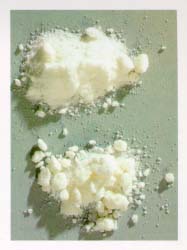|
Crack
and Cocaine

Powdered Cocaine

Chunk Crack
What are the street
names/slang terms for it?
Cocaine: Big C, Blow, Coke,
Flake, Lady, Nose candy, Snow, Snowbirds, WhiteCrack:
Freebase, Rock
Cocaine is a powerfully
addictive drug of abuse. Once having tried cocaine, an
individual cannot predict or control the extent to which he
or she will continue to use the drug.
The major routes of
administration of cocaine are sniffing or snorting,
injecting, and smoking (including free-base and crack
cocaine). Snorting is the process of inhaling cocaine powder
through the nose where it is absorbed into the bloodstream
through the nasal tissues. Injecting is the act of using a
needle to release the drug directly into the bloodstream.
Smoking involves inhaling cocaine vapor or smoke into the
lungs where absorption into the bloodstream is as rapid as
by injection.
"Crack" is the
street name given to cocaine that has been processed from
cocaine hydrochloride to a free base for smoking. Rather
than requiring the more volatile method of processing
cocaine using ether, crack cocaine is processed with ammonia
or sodium bicarbonate (baking soda) and water and heated to
remove the hydrochloride, thus producing a form of cocaine
that can be smoked. The term "crack" refers to the
crackling sound heard when the mixture is smoked (heated),
presumably from the sodium bicarbonate.
There is great risk whether
cocaine is ingested by inhalation (snorting), injection, or
smoking. It appears that compulsive cocaine use may develop
even more rapidly if the substance is smoked rather than
snorted. Smoking allows extremely high doses of cocaine to
reach the brain very quickly and brings an intense and
immediate high. The injecting drug user is at risk for
transmitting or acquiring HIV infection/AIDS if needles or
other injection equipment are shared.
Health
Hazards
Cocaine is a strong central
nervous system stimulant that interferes with the
reabsorption process of dopamine, a chemical messenger
associated with pleasure and movement. Dopamine is released
as part of the brain's reward system and is involved in the
high that characterizes cocaine consumption.
Physical effects of cocaine
use include constricted peripheral blood vessels, dilated
pupils, and increased temperature, heart rate, and blood
pressure. The duration of cocaine's immediate euphoric
effects, which include hyper-stimulation, reduced fatigue,
and mental clarity, depends on the route of administration.
The faster the absorption, the more intense the high. On the
other hand, the faster the absorption, the shorter the
duration of action. The high from snorting may last 15 to 30
minutes, while that from smoking may last 5 to 10 minutes.
Increased use can reduce the period of stimulation.
Some users of cocaine report
feelings of restlessness, irritability, and anxiety. An
appreciable tolerance to the high may be developed, and many
addicts report that they seek but fail to achieve as much
pleasure as they did from their first exposure. Scientific
evidence suggests that the powerful neuropsychologic
reinforcing property of cocaine is responsible for an
individual's continued use, despite harmful physical and
social consequences. In rare instances, sudden death can
occur on the first use of cocaine or unexpectedly
thereafter. However, there is no way to determine who is
prone to sudden death.
High doses of cocaine and/or
prolonged use can trigger paranoia. Smoking crack cocaine
can produce a particularly aggressive paranoid behavior in
users. When addicted individuals stop using cocaine, they
often become depressed. This also may lead to further
cocaine use to alleviate depression. Prolonged cocaine
snorting can result in ulceration of the mucous membrane of
the nose and can damage the nasal septum enough to cause it
to collapse. Cocaine-related deaths are often a result of
cardiac arrest or seizures followed by respiratory arrest.
What is its federal
classification?
Cocaine is a Schedule II
drug
|